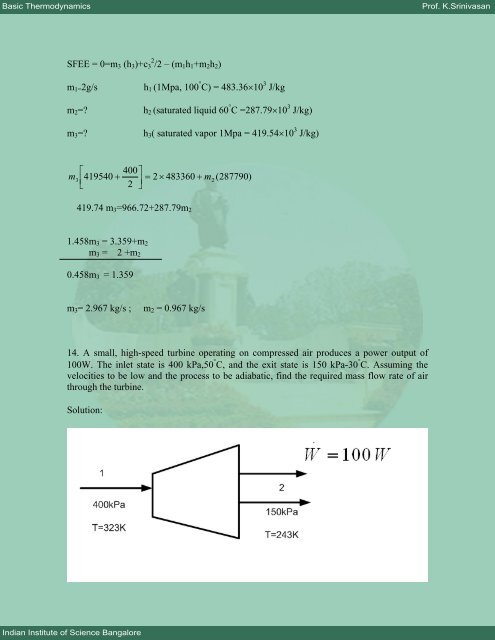Problems and Solutions - E-Courses
Problems and Solutions - E-Courses
Problems and Solutions - E-Courses
You also want an ePaper? Increase the reach of your titles
YUMPU automatically turns print PDFs into web optimized ePapers that Google loves.
Basic Thermodynamics Prof. K.Srinivasan<br />
SFEE = 0=m3 (h3)+c3 2 /2 – (m1h1+m2h2)<br />
m1=2g/s h1 (1Mpa, 100 ° C) = 483.36×10 3 J/kg<br />
m2=? h2 (saturated liquid 60 ° C =287.79×10 3 J/kg)<br />
m3=? h3( saturated vapor 1Mpa = 419.54×10 3 J/kg)<br />
m 3 ⎢<br />
419540 + = 2×<br />
483360 + m2<br />
( 287790)<br />
2 ⎥<br />
⎣<br />
⎦<br />
400⎤<br />
⎡<br />
419.74 m3=966.72+287.79m2<br />
1.458m3 = 3.359+m2<br />
m3 = 2 +m2<br />
0.458m3 = 1.359<br />
m3= 2.967 kg/s ; m2 = 0.967 kg/s<br />
14. A small, high-speed turbine operating on compressed air produces a power output of<br />
100W. The inlet state is 400 kPa,50 ° C, <strong>and</strong> the exit state is 150 kPa-30 ° C. Assuming the<br />
velocities to be low <strong>and</strong> the process to be adiabatic, find the required mass flow rate of air<br />
through the turbine.<br />
Solution:<br />
Indian Institute of Science Bangalore

















